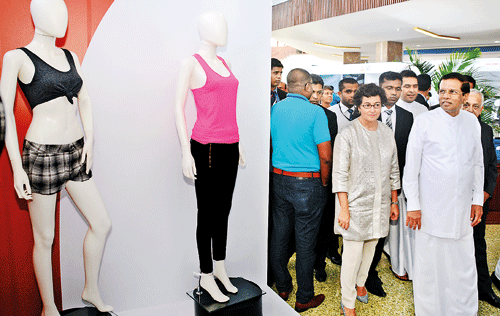Growth possible only thro’ exports not remittances – PM

"I am also slim' - the President seems to think as he visits some of the items displayed at the WEDF on the opening day. Pix by M.D. Nissanka
Sri Lanka’s exports which has been facing a major crisis in the past decade is re-looking at the markets and opportunities worldwide. The country has decided to refocus attention on exports, growth and expansion of employment, said Prime Minister Ranil Wickremesinghe speaking at the World Export Development Forum 2016 held in Colombo on Wednesday. “The forum is held in Sri Lanka at a time where the country has decided to refocus attention on exports, growth and expansion of employment. For about 8 to 9 years we lost our focus on exports. We had the GSP+ to enter Europe so did Bangladesh. We gave it up, but Bangladesh kept on virtually increasing its export earnings on garments alone by about five times.” “Our focus is on foreign remittances but that is limited. When people have good jobs they want to enter the middle class and earn higher incomes. That growth can come only through exports, not through remittances,” he added.
The opportunities the country has missed in growth and revenue are numerous. The country is dependent on foreign loans and commercial borrowings. The end result is that people don’t have satisfactory jobs. The government of Sri Lanka first focused on the political targets of creating one million jobs and expanding them. To achieve these targets in a short time a national government was formed. This was a war of how to get the investments, how to go out and capture the export markets, he said. “With this was in line we focused on making Sri Lanka the hub of the Indian Ocean for business, logistics and finance and go for development of our three major ports Colombo, Hambantota and Trincomalee and the two airports in Katunayake and Mattala. The facilities available for logistics and communication make it attractive for business and finance. Then let Sri Lanka become a platform for competitive value addition and to join the global value addition chain.
This being our strategy for the future, we spent one year working on it, most of it will be announced next month with the 2017 budget,” noted Mr. Wickremesinghe. He said that Sri Lanka has to find new markets and sign up agreements. “I will be visiting Brussels to renegotiate the GSP+ for Sri Lanka. But unlike in 2002 when growth depended only on Europe the shift is coming towards Asia. There are three important agreements. One with India, the Economic and Technology Corporation Agreement (ETCA) which enables us close cooperation with five southern states in India. India being the fastest growing economy in the Indian Subcontinent and with a combined GDP of US$ 500 million, there is a lot of scope with Sri Lanka and India working together.” He also stated that the government is negotiating a triangular arrangement of Free Trade Agreement (FTA), between the three countries Sri Lanka, India and Singapore. “Later on we will also negotiate FTA’s with the other Bay of Bengal countries.
Bay of Bengal will be a fast growing area with fast growing income generation region in the next 20 to 30 years. We are also having discussions with China on an FTA and a 5- year comprehensive economic partnership dialogue with Japan. This way we are looking at the Asian and European markets.” New incentives for Foreign Direct Investment (FDI) and local investments will be announced soon, noted Mr. Wickremesinghe. “One area that we are focusing is to give incentives for the domestic manufacturing industries to become competitive and go out to the world market. We have a fairly good manufacturing industry catering to the domestic market. But that alone is not enough and will not create employment opportunities. As we become competitive while we are encouraging FDI of those who come into the country, we have the local industries’ potential to expand and go into the nearby markets if they do well.”
China’s Vice Minister of Commerce Wang Shouwen said that in the past five decades global exports grew at 10 per cent on average every year much higher than the average growth rate of the world economy. “Since 2009 when the financial crisis erupted the world economy has been struggling to recover and global trade has been below economic growth,” he added. He also mentioned that China has concluded 14 FTA’s covering 22 countries and regions worldwide. Attracting FDI is important for trade growth which not only brings funding, market and technology but also brings the latest ideas in management operation that can help drive indigenous, innovative models and trade expansion in most countries. He assured that China will sign a FTA with Sri Lanka soon.


